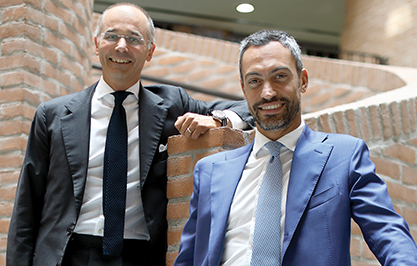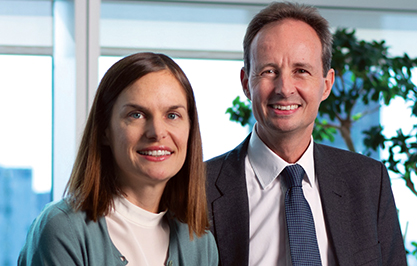When Italian utility company Enel sought to issue the first corporate bond linked to the UN Sustainable Development Goals, it chose Société Générale, which has a wealth of SDG knowledge, as joint bookrunner and sole swap counterparty. Edward Russell-Walling reports.
Italian energy company Enel has made a little piece of bond market history by issuing the first-ever corporate bond linked to the UN Sustainable Development Goals (SDG). In another first, the associated currency swap was also SDG-linked. Société Générale was a joint bookrunner and the sole swap counterparty.
Enel, which has a larger customer base than any of its European competitors, puts sustainability at the centre of its brand. This is partly a reflection of the national character; the Italian public has long been environmentally conscious and more than 90% voted against nuclear power in a 2011 referendum. Italian governments generally echo this eco-awareness, and the state still owns nearly 24% of Enel.
“There has been a commitment from top management down to all business lines that Enel should be one of the global leaders in sustainability,” says Michele Cortese, head of debt capital markets (DCM) for Italy and Greece at Société Générale. The company has been a regular issuer of green bonds, he adds.
The eligibility issue
Earlier this year, Enel began to consider how to extend the reach of its sustainable financing. The Green Bond Framework, which governs exactly what constitutes a green bond, stipulates that any proceeds must be used to finance or refinance eligible assets – for example, green buildings, renewable energy or projects with a positive environmental impact.
The selection criteria are quite strict, which limits the volume of green bonds that any single issuer can create. “For Enel, as for many issuers, it is a challenge to find enough eligible assets on a recurrent basis,” says Stephane Marciel, head of sustainable bonds, DCM, at Société Générale. “Enel’s activities make a greater contribution to the fight against climate change than its green bond issuance shows, and it wanted to illustrate that point on the finance front.”
A SDG-linked instrument is more flexible than a green bond because the funds raised can be used for general purposes, and so volumes are not constrained by the availability of eligible assets. The World Bank has issued a number of SDG-linked bonds, starting in 2017, but Enel’s is the first from a corporate issuer and the first to raise funds for general purposes.
As a business, Enel focuses on four particular SDGs: SDG 7 (affordable and clean energy); SDG 9 (industry, innovation and infrastructure); SDG 11 (sustainable cities and communities); and SDG 13 (climate action). The company’s inaugural bond is linked to SDG 7 or, more specifically, to SDG 7.2, which calls for a substantial increase in the share of renewable energy in the global energy mix by 2030.
Enel is committed to raising its percentage of installed renewable capacity to at least 55% of the total by the end of 2021. (At the end of June 2019, it stood at just under 46%.) If that target is not achieved, the new bond’s coupon will be stepped up from the next interest period onwards. “This target has not come out of the blue; it was already a commitment to stakeholders,” says Mr Marciel. “Enel has published sustainability targets and issued corporate social responsibility reports for many years, and the bond is consistent with the medium- and long-term strategy of the company.”
The next suitable window for issuance came in September 2019. Though the US dollar market was slightly more expensive versus the euro, US dollar investors were targeted for two important reasons. Enel had already done a considerable volume of its 2019 funding in the euro markets, and there was a critical mass of environmental, social and governance (ESG) investors in the US.
Hedging necessary
Given Enel’s euro-denominated balance sheet, the transaction would need to be hedged. How could the cross-currency swap be structured to complement the sustainable character of the bond itself? The Société Générale team started brainstorming possibilities.
“We have had top-rated ESG research for the past 12 years,” says Isabelle Millat, Société Générale head of sustainable investment solutions for global markets. “Last year, Société Générale did a lot of sustainability-linked loans. So now we have switched that expertise into the hedging space.”
There was nothing comparable in the market, says Riccardo Terzolo, head of corporate derivatives sales and bank solutions, Italy, at Société Générale. The resulting swap was fully aligned with the underlying bond. “If Enel doesn't reach its target by December 2021, the step-up in the coupon will be mirrored in the cross-currency swap,” he says. “The sustainability price adjustment in the swap will disappear.”
In its dealings as the sole swap counterparty, Société Générale will support the UN Environment Programme’s positive impact finance initiative whose principles, it says, are fully aligned with the underlying bond.
Plenty of banks
In the first week of September, Enel launched a benchmark five-year general purpose SDG-linked bond – 'benchmark' suggesting $1bn or more. Alongside Société Générale, there were seven other joint bookrunners: BNP Paribas, Bank of America Merrill Lynch, Citi, Crédit Agricole, Goldman Sachs, JPMorgan and Morgan Stanley. That may seem like a lot of banks, but Enel has more than 30 domestic and international banking relationships. Indeed, as an Enel transaction, this was notable for its relatively limited number of bookrunners.
Initial pricing thoughts were US Treasuries plus 150 basis points (bps), having reference to Enel’s outstanding US dollar curve, but including a new issue premium. “There was a strong market reaction, with more than $4bn of interest,” says Mr Cortese. “There were enough high-quality investors in the book for us to tighten the official guidance by 25bps, to 125bps.”
That did not deter too many investors, and the book remained just short of $4bn. The issue size was set at $1.5bn, with a coupon of 2.65%, a conditional 0.25% penalty step-up and a reoffer spread of Treasuries plus 125bps. While US investors took the lion's share, at 73% of geographical distribution, European participation was higher than expected. Some 12% went to France and 8% to the rest of Europe. Asset managers were the main investor type, with 81% of the allocation, and bankers say that a “good chunk” went to ESG funds.
In secondary trading, the bonds have tightened by a couple of points, suggesting that, while some buyers wanted to add to their allocations, most investors had bought to hold.
Growing interest
Since the deal broke, Société Générale has had “many” calls from genuinely interested corporates. “The transaction has attracted a lot of attention, particularly for issuers whose activities contribute significantly to sustainable goals but who lack eligible assets,” says Mr Marciel.
The product could appeal to certain sectors which, until now, have not been associated with green funding. Mr Marciel believes that SDG-linked bonds could play a role in agriculture, for example, or in sustainable mining, which produces key metals for renewable energy. This is not, however, the beginning of the end for the green bond, he insists. “SDG-linked bonds are complementary to green bonds,” he says. “The fight against climate change is an enormous challenge, particularly in emerging markets, and we need additional instruments, not replacements.”
Mr Cortese says he has now spoken to many firms in Italy about the SDG-linked product. “Some of them would love to go down the SDG path but, for the time being, have to stick to green or social bond structures,” he says. “That's because, although they could pinpoint UN SDG targets in their corporate activities, it is not so easy to get top management fully aligned.”
Finally, the Société Générale bankers agree that, more than most, this particular transaction relied heavily on teamwork across coverage, DCM, derivatives, sustainable bonds, research and legal, among others. As Ms Millat says: “This deal was the poster child for the teamwork approach.”




